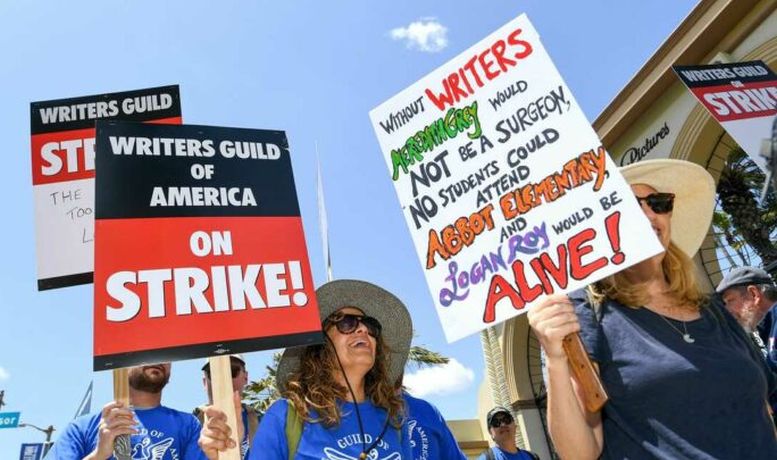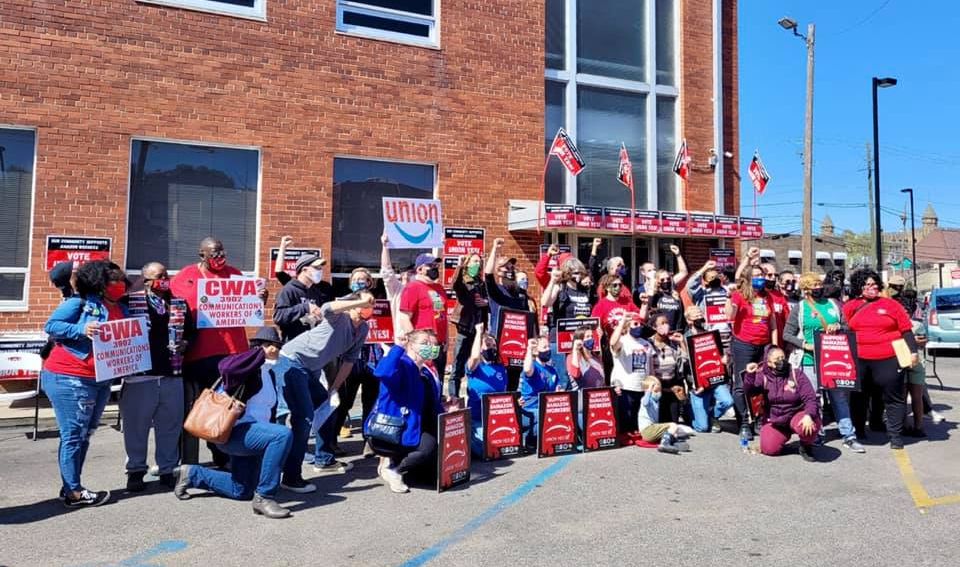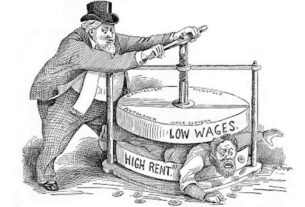David Rhoades is a member of Socialist Alternative in the US.
After 148 days on strike, the Writers Guild of America (WGA) forced the Association of Motion Picture and Television Producers (AMPTP) back to the negotiation table and squeezed major concessions out of frustrated studio heads. With a tentative agreement that surrenders ground to the writers on AI usage, staffing minimums, and streaming residuals, the film and TV strike has demonstrated what’s possible when a strong strike escalates again and again.
Ultimately, the writers got a strong deal because the Screen Actors Guild (SAG) joined them on strike in July. SAG striking with the writers halted production in Hollywood, robbing studios of the leverage to wait out the WGA. The dual strike tactic not only escalated it in terms of size—SAG has nearly 10 times the membership of the WGA – but also gave it the character of an industry strike.
American workers have seen two potentially explosive near-strikes end in disappointment over the last year. Progressive Democrats in Congress went along with a scheme to break the railroad strike last winter. In July, Socialist Alternative supported a “Vote No” campaign against the weak UPS Teamster tentative agreement that UPS executives celebrated as a “win for both sides.” But with an oncoming recession, record inflation, and stagnant wages, workers don’t need dilute compromises; we need victories.
That’s what makes the WGA struggle so notable: there was no illusion of compromise. The workers wanted an unprecedented deal; the studios wanted to starve them into submission.
What The Writers Won
Among the gains for workers listed in the tentative agreement are terms dictating that studios cannot use ‘AI’ language learning models (LLMs) to make any scripts, treatments, or narrative work of any kind or require any writer to use them; that streamers must disclose streaming data to the WGA and pay 50% residual bonuses to shows above a certain performance threshold; and that streamers must employ a minimum of three writers for at least ten weeks for development rooms, with longer employment guarantees for greenlit shows.
While there are numerous wins included in the tentative agreement, studio concessions on the use of AI, streaming transparency and residuals, and minimum staffing deserve special attention. From the start, these three demands were irreconcilable with the AMPTP’s interests; during the May 1 negotiations, the studios refused these demands outright without a counter proposal.
It was in reference to these demands that Bob Iger, CEO of Disney, patronizingly lectured the actors and writers to “be realistic about the business environment, and what this business can deliver.” As it turns out, the strikers were indeed being realistic.
The primary lesson from this struggle is that when bosses say a demand isn’t realistic, what they mean is “you’ll have to fight me for it.”
Fighting The Gig-ification Of Writing
Many strikers blamed corporate greed for the refusal to entertain these demands, which is mostly true. But it goes deeper than personal greed: the writers took on an entire business model that, until now, ruled the film and TV industry.
The rise of streaming under Big Tech led studios to abandon advertising revenue for subscriber revenue. The switch necessitated all of the practices the WGA was striking against: mini-rooms, absurdly small residuals, and the threat of AI replacement.
For the studios to convert film and TV writing into low-paid gig work, they needed to crush the union completely. That was the cold, capitalist logic behind the plan to wait out the writers until they started losing their homes, which one anonymous studio source called a “cruel but necessary evil.”
As a result, this contract fight took on broader significance than previous contracts.
Through an uncompromising strike that highlighted the class differences between the bosses and the workers, writers have shown it’s possible to bring labor-saving devices under worker control, to secure guaranteed employment and staffing, and to force tech companies to yield up their most valuable asset: data.
Now that these are written into their contract, writers have opened the door for demanding increased staffing, longer employment guarantees, or large streaming residuals for all productions.
Lessons Of The Writers’ Strike
There are multiple factors that made the writers’ win possible.
The first is the dual strike. Solidarity and industry-wide action robbed the studios of leverage, reinforced the pickets, and demonstrated how all workers share the same interests.
Flowing from this, workplace organizing has started spreading to other areas of film/TV production. The VFX artists who work for Marvel Studios – some of the most infamously overworked artists in the industry – have recently voted to unionize. Reality TV stars have expressed the need for performer protections, and SAG announced their intent to take up that fight. SAG members voted for a second strike against video game companies, where workers have begun to organize. WGA East promised to organize animation writers on the East Coast after the strike.
The studios hoped to make an example of the writers and actors; in a sense, they did.
The second factor that made these gains possible was a militant perspective. Working writers like Adam Conover (a negotiating committee member) were instrumental in polarizing the strike, highlighting the mutually exclusive interests of workers and bosses while calling out the union’s enemies openly and unapologetically. This approach was a bracing dose of reality after decades of the labor movement treating contracts like collaborations between workers and bosses, not zero-sum struggles for survival.
Polarizing the struggle maintained the strength of the strike for its entire duration. The strike had 60% public support by its end, according to a Reuters poll. The Drew Barrymore Show and Real Time with Bill Maher received such vehement backlash after announcing they would resume production that they rescinded their announcements almost immediately.
It’s exceedingly rare for a strike as lengthy as the writers’ to end in a position of strength. Long strikes are a risk: the longer workers aren’t getting paid, the more vulnerable they are to getting starved off the pickets (or out of an entire industry). Strikes that stop production immediately and concentrate all pressure on the company’s profits immediately are more likely to win.
Protecting The Victory Demands Increased Militancy
Some writers and actors have correctly expressed skepticism about whether streaming companies will report accurate audience numbers, per the proposed contract. Currently, only six Guild leaders are allowed to review viewership data, but they’ll be bound to a confidentiality agreement with the bosses. Every WGA member went out on the pickets to fight for streamer transparency, yet workers still won’t be allowed to know precisely how much value their labor produces. Even if the union calls for an audit – one of the contract’s protections – members wouldn’t be allowed to know the results of that audit. It drives a wedge between the membership and its leaders.
There’s also concern about how studios might get around specific protections; for instance, residuals for streaming films apply to movies with a budget of $30 million or more. “What do you want to bet that AMPTP companies start making $29.9 million movies?” WGA writer Melody Cooper said.
These concerns have precedent; studios often use finance trickery to pocket what would be paid out to workers, like ensuring revenue-generating movies “lose” millions every year decades after release.
Writers’ concerns make it clear that they’ll need to defend their victory. The strengths of this tentative agreement notwithstanding, the struggle isn’t over. A contract is only as strong as the membership that enforces it.
To put it bluntly, the studios aren’t going to stop trying to grind down writers’ wages or get around paying residuals. When they test the strength of the contract, writers will need to fight back, and go on the offensive with new demands to amend the contract in the future. For that to be remotely possible, member militancy has to continue developing through to the 2026 contract fight.
The major streaming platforms have already formed a lobbying group to fight for their interests on the political stage. They’ve hired a 36-year Congressman and a former chair of the FCC to leverage their political connections – one Republican and one Democrat, to cover their bases. Any hope in the Democrats is misplaced: Governor Newsom prevented any unemployment relief from going to striking actors and writers just two days before the actors’ negotiations were supposed to begin. Given that workers don’t have a political party in the US, this is an arena where the WGA and SAG – and all unions, in fact – are at a severe disadvantage.
The AMPTP will begin negotiations with SAG on October 2, indicating the studios seek a conclusive end to the strike. Meanwhile, the writers will vote on the tentative agreement from October 2 to October 9. Regardless of what happens, the writers have secured concessions that the bosses said could never happen — a testament to their endurance and the power of the working class.
Solidarity with the members of WGA and SAG. IATSE, you’re up next.




